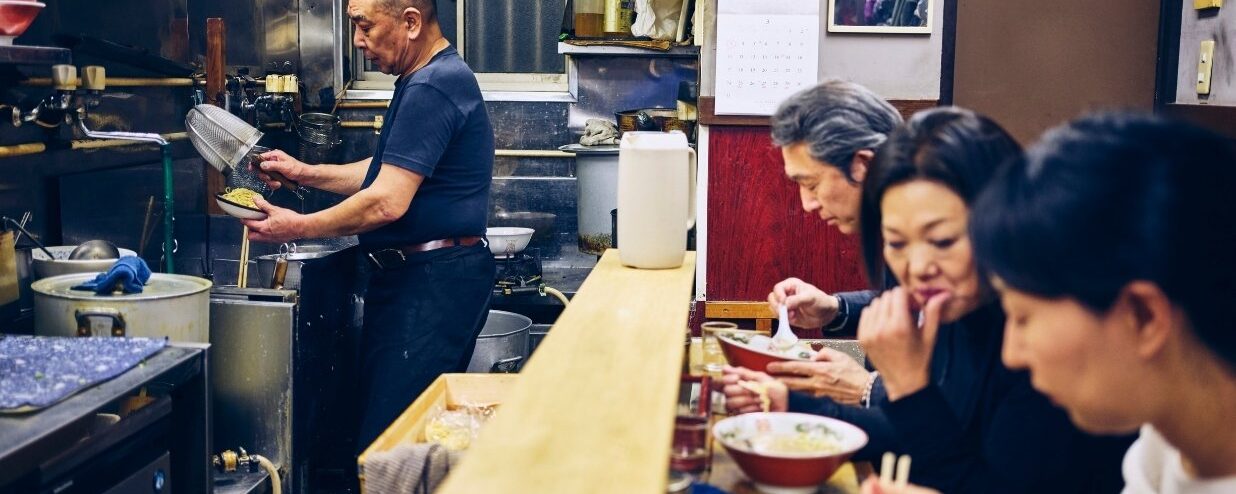Alphabet is the foundation of the English language, and the same thing can be said about hiragana in the Japanese language. Mastering hiragana is important for anyone who wants to learn the basics of Japanese. As one of the two Japanese alphabets — right next to katakana — hiragana is used for both Japanese grammars and function words. Today, we’ll be learning about the Japanese hiragana ra and ramen.
Having a strong foundation of hiragana means having a generally strong foundation of Japanese skills, too. Yet despite its importance, it shouldn’t take a long time for you to master hiragana. In fact, with the right teacher and support, it should only take no longer than a week for you to master hiragana, including reading and writing them. Hiragana’s shapes are relatively simple, especially if you compare them to kanji. Dwell no further. In this blog series, we’ll be breaking down all the Japanese phonetics (AIUEO or あいうえお) for beginners.
Want to get a fuller view of the hiragana chart for your Japanese study? Check out our article on learning hiragana!

Today’s Japanese Hiragana: Ra (ら)
The hiragana characters for the ‘R’ family have one of the most simple strokes — most of them are less than one stroke and, at the very most, two. There are the ra, ri, ru, re, ro (ら、り、る、れ、ろ). The character for ra contains two strokes. Remember to follow the stroke order and practice writing them as it is a great way to help you master hiragana in a short time.
Learn a Japanese word from Ra (ら): Ramen (ラーメン)
When you learn the Japanese hiragana alphabet ra (ら), you may think of the ramen (ラーメン). The world loves ramen, but no one can match the same obsession that Japanese people have. In fact, it’s so popular, that there are over 30,000 ramen shops in Japan. Depending on the area and shop (and local specialties), the taste of the soup and the type of noodles also vary. Everyone has their own favorite, but each one of these bowls is just as delicious. This time, I am going to tell you about the phrases that you need to know when ordering ramen at a shop.
A ramen enthusiast? Check out our article for the best ramen shops in Tokyo.
Common Japanese phrases when ordering at a ramen shop
A lot of popular ramen chains in Tokyo provide English menus, but small ramen shops are the true hidden gems — and, most of the time, they will only hand out Japanese menus. Learn these useful Japanese words and phrases so you don’t get lost when ordering a bowl of ramen.
Japanese Vocaulary for Noodles
Let’s start with noodles! Depending on the shop, you might be able to choose how firm you want your noodles.
- Soft – やわらかめ(yawarakame)
- Medium – 普通(futsuu)
- Slightly Firm – やや硬め(yaya-katame)
- Firm – 硬め(katame)
- Hard – バリ硬(bari-kata)
- Wire – 針金(harigane)
Japanese Vocabulary for Ramen Soup Preference
- Light – あっさり(assari): Soup is refreshing and not greasy.
- Rich – こってり(kotteri): Soup is oily with a strong flavor and stock from pork bones.
- Very Rich and Thick – 超こってり(cho-kotteri): Soup has a very strong flavor with lots of oil.
Japanese Vocabulary for Ramen Toppings
- Cha-siu – チャーシュー(cha-shu): The king of ramen toppings! It is marinated pork that is cooked and thinly sliced.
- Aji-tsuke Tamago – 味付け卵(ajitsuke-tamago), or Aji Tama味玉(ajitama): A boiled egg that is marinated in soy sauce.
- Menma – メンマ(menma): Bamboo shoot that is boiled and fermented.
- Green onions – ねぎ(negi): A herbal flavor that ramen must have! In Kanto(Eastern Japan), white long onions are popular, while green onions are popular in Kansai(Western Japan).
There’s a lot of ways you can customize your ramen — although we can’t guarantee the salaryman beside your booth won’t raise an eyebrow. It’s easy to fall into the temptation of ordering all the toppings.
Additional Information
On top of all the information above, here’s two additional things which, if you know, would make you an expert!
- Kae-dama – 替え玉(kae-dama): Asking for seconds on only the noodles, without soup.
- Soup Wari – スープ割り(soup-wari): After finishing the tsukemen noodles, diluting the tsuke sauce with stock soup so that you can drink it.
Quiz!
At a particular ramen shop in the city, there is a menu called “Designated R-20” (individuals who are under 20 years old cannot order from it). So, what’s the secret indgredient in that ramen? ?
The answer is tequila! The menu has a notice, stating “Entirely Alcohol”. I heard that it even comes with lime, which is a must-have with tequila. It seems to be quite a special custom. If you want to experience getting drunk while eating ramen, definitely go try it!
Ayana Nezu has a long history in education and training. In 2017, she joined Coto Language Academy – her first time in a Japanese Language School. She currently is based at our Azabu Coto Japanese Club location and is recently obsessed with Rakugo.

